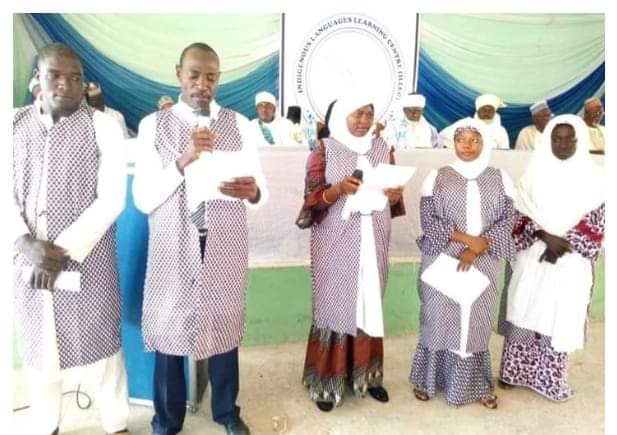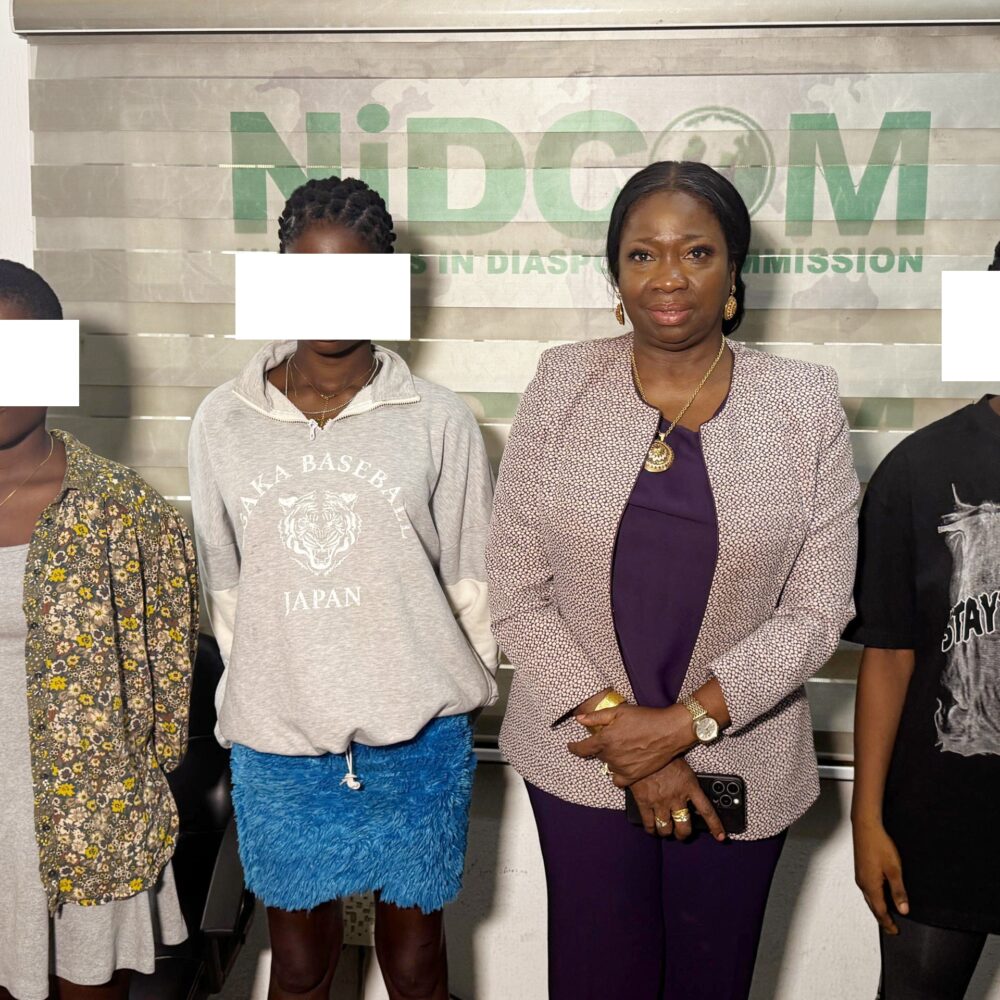Please, do Study Nupe Vowel & Consonant sounds carefully and get yourself out of the wood of the Learning of Nupe Language.
DZATSA – VOWEL
DZATSA:- Wun yi Egiminkazhi na e la eganminsun a detsa na – Vowel is a speech sound that allow letters to function.
DZATSA ZHI YI GUTSUN = VOWELS ARE FIVE
Aa Ee Ii Oo Uu
Aa = No
Ee = Yes
Ii = Ewu / in sound
Oo = Ewu / in sound
Uu = Ewu / in sound
TITI DZATSAZHI – TYPES OF VOWEL
1. Dzani – monophthongs,
2. Dzaba – diphthongs
1. Dzani – Monophthongs:- wun yi eganmin na de egiminka dzatsa nini kerente na. It’s a word-class that has only one vowel letter.
SANTATUNZHI – EXAMPLES
i. Be – Come, ii. Ca – Start,
iii. Din – Reduce, iv. Fan – Fold,
v. Gun – Complete, vi. Jin – Do,
vii. Kan – Stop, viii. Li – Choose,
ix. Man – Borrow, x. Na – Wash.
2. Dzaba – Diphthongs:- wun yi eganmin na de egiminka dzatsa guba na. It’s a word-class that has two vowel letters.
SANTATUNZHI – EXAMPLES
1. Bau – Count-it,
2. Cau – Start-it,
3. Deu – Got-it,
4. Fou – Hang-it,
5. Gau – Pay-back
LABAGI – CONSONANT
Labagizhi yi Egiminkazhi nazhi gikini ya ewu na e fetinya emin yi bo na. Ewu nana e wugwa kpikpe nya emin naman e la egan dzunzhin wanginyi a na. Santatun; wo a gintara laba yita yikan yegboro, koman wo a eminkperezhi kpe. (Consonants are letters that stand for a type of sound we use in speech. These sounds involve a partial or complete closure of the vocal tract: for example, placing the tongue behind the front teeth, or closing your lips).
TITI LABAGIZHI – TYPES OF CONSONANTS
1. Bakeminkpere – Bilabial,
2. Nuwangi – Nasal,
3. Fyashi – Fricative,
4. Fyatswan – Affricate,
5. Egungba – Aapproximant.
1. Bakeminkpere – Bilabial:- Labagizhi nya bakeminkpere e de dide woga yiyi efe te minsun o gwata eminkpere la gun dozhi o na. Nupe kpan labagizhi nya bakeminkpere guwo. Ah dana ke anini na:
Bilabial consonants occur when you block/constrict airflow out of the mouth by bringing your lips together. Nupe contains the following ten consonants:
/m/ dan mini egan “mandan” betoh Emin”
/mw/ dan mini egan “mwanyi”
/my/ dan mini egan “myagi”
/nm/ dan mini egan “nma”
/p/ dan mini “pati” betoh “nimpa”
/kpw/ dan mini egan “kpwa”
/kp/ dan mini egan “kpalo” betoh “tikpa”
/gb/ dan mini egan “gbando” betoh “yagba”
/b/ dan mini egan “banti” betoh “caba”
/gbw/ dan mini egan “gbwadwa”
2. NUWANGI – NASAL
Labagizhi nya nuwangi e de tsutswa kamina woga efo efe te minsun o na, woci lugwa efe ci e la efe tinya gwata eye o na. Nasal consonants are created when you completely block air flow through your mouth and let the air pass through your nose.
Nuwangi labagizhi nya zhimin Nupe dana ke anini na. (Nupe Nasal Consonants are as follows)
/m/ – “mandan” betoh Emin” – yeko egantinya a te gwata tsutsu eminkperezhi o (bakeminkpere).
/mw/ – “mwanyi” – yeko egantinya a te gwata tsutsu eminkperezhi o (bakeminkpere).
/my/ – “myagi” – yeko egantinya a te gwata tsutsu eminkperezhi o (bakeminkpere).
/n/ – “na” betoh “ena” – yeko egantinya a te gwata egwato gintara tigi lo gyakun nyi. (gikun).
/nn/ – “nna” – yeko egantinya a te gwata egwato gintara tigi lo gyakun nyi. (gikun).
/ny/ – “nya” betoh “nyi u” – yeko eganyinya e lade tite gwata tutu gintara tizogi loba tasa o (etasa).
/nm/ – “nma” – yeko egantinya a te gwata tsutsu eminkperezhi o (bakeminkpere).
/nd/ – “nda” – yeko eganyinya e la de tite gwata tutoh gintara zuman loba tasa gwadwagi (etasa).
/nk/ – “nko” – yeko eganyinya e la de tite gwata tutoh gintara zuman loba tasa gbwadwagi (etasa).
3. FYASHI – FRICATIVE
Na labagizhi nya nuwangi betoh ba/kpe e la de tite pangagi eyikpakpagi egan o gunmin na, ewuzhi nya fyashi e kpan tsutsu etunlo nya pangagi eyikpakpangi, ebo efe u deba u tin u ya be kpaka e gwata yeko edzun ezanda o.
Eri ke gbani na, wo tswa egiminka /t/ na yi ba/kpe labagi na woga a efo efe te kpata na be tutoh gintara tigi lo gyakun i. Anma woga gintara dzu ya efin deginyi woci lugwa efe a sanya gwata u bo, wo a ewu egiminka /s/ tswa na yi fyashi labagi na.
Ewuzhi nya fyashi zhimi Nupe ndocizhi de rikpe be nya Nasara e. Ah dana ke anini na:
/f/ – “fara” betoh “efu” – efe e gogan be kpaka e gwata yikan-tita betoh eminkpere-tako e (yikantitakominkpere).
/fw/ – “fwanfwan” – efe e gogan be kpaka e gwata yikan-tita betoh eminkpere-tako e (yikantitakominkpere).
/fy/ – “fyanyi” betoh “efyan” – efe e gogan be kpaka e gwata yikan-tita betoh eminkpere-tako e (yikantitakominkpere).
/v/ – “vavanyi” – efe e gogan be kpaka e gwata yikan-tita betoh eminkpere-tako e (yikantitakominkpere).
/vy/ – “vyavyagi” – efe e gogan be kpaka e gwata yikan-tita betoh eminkpere-tako e (yikantitakominkpere).
/vw/ – “evwan” – efe e gogan be kpaka e gwata yikan-tita betoh eminkpere-tako e (yikantitakominkpere).
/s/ – “saba” betoh “garasa” – efe e gogan go be kpaka e gwata gintara be gyakaun i (gikun).
/sw/ – “swarwa” betoh “eswa” – efe e gogan go be kpaka e gwata gintara be gyakaun i (gikun).
/z/ – “zayegi” betoh “eza” – efe e gogan go be kpaka e gwata gintara be gyakaun i (gikun).
/dz/ – “dzakangi” betoh “edza” – efe e gogan go be kpaka e gwata gintara be gyakaun i (gikun).
/sh/ – “sheshi” betoh “yeshi” – efe e gogan go be kpaka e gwata gintara be dana tita nya gyakun i (tita-gikun).
/ts/ – “tsakagi” betoh “etsa” – efe e gogan go be kpaka e gwata gintara be gyakaun i (gikun).
/tsw/ – “tswafo” betoh “etswa” – efe e gogan go be kpaka e gwata gintara be gyakaun i (gikun).
/ty/ – “tyangi” betoh “etyan” – efe e gogan go be kpaka e gwata gintara be gyakaun i (gikun).
/zh/ – “zhihe” betoh “ezhe” – efe e gogan go be kpaka e gwata gintara be dana tita nya gyakun i (tita-gikun).
/h/ :- shi u bo shishi toh zhimi Nasara o /h/ wun jin ewu fyashi a. Wun jin ewu nya labagi o tso na tinye na a, tun na wun de ekpa gbigba nya ezanda efe a na.
While nasal and stop consonants involve a complete blockage of the vocal tract, fricative sounds involve only a partial blockage of the vocal tract so that air has to be forced through a narrow channel.
For example, you create a /t/ stop consonant when you block airflow completely with your tongue against the alveolar ridge. But if you let up with the tongue a bit and let the air seep through, you make an /s/ fricative consonant.
The English fricative sounds are as follows:
/f/ – “fro” and “calf“- air is forced through the upper teeth and lower lip (labiodental)
/v/ – “vine” and “have” – air is forced through the upper teeth and lower lip (labiodental)
/θ/ – “thick” and “bath” – air is forced through upper teeth and tongue (dental)
/ð/ – “the” and “rather” – air is forced through upper teeth and tongue (dental)
/s/ – “suit” and “bus” – air is forced through tongue and alveolar ridge (alveolar)
/z/ – “zit” and “jazz” – air is forced through tongue and alveolar ridge (alveolar)
/ʃ/ – “shot” and “brash” – air is forced through the tongue and point just beyond alveolar ridge (post-alveolar)
/ʒ/ – “vision” and “measure” – air is forced through the tongue and point just beyond alveolar ridge (post-alveolar).
/h/ – “happy” and “hope” – actually /h/ isn’t a fricative. It’s technically not even a real consonant sound since there’s no constriction/obstruction of airflow.
4. FYATSWAN – AFFRICATE
Ba/kpe labagizhi ga a zhin keba be fyashi labagizhi, ezhe e la zhe fyatswan labagi. Fyatswan labagizhi ae caca be ewuzhi nya ba/kpe be tutu nya efe eba yiyi tinya na e tinya gwata yeko edzun ezanda o ci e la fe ke fyashi na (na u gonyi u tin u tinya ponyi bunyi ke ba/kpe na e).
Ewuzhi nya fyatswan zhimin Nupe dana ke anini na:
/c/ – “caba” betoh “ecan” – efe e la de tite be gintara e kasanta gyakun o (tita-gikun), ci e tinya ke fyashi na.
/j/ – “janfuru” betoh “eje” – efe e la de tite be gintara e kasanta gyakun o (tita-gikun), ci e tinya ke fyashi na.
When stop consonants mix with fricative consonants, the result is an affricate consonant. Affricate consonants start as stop sounds with air building up behind an articulator which then releases through a narrow channel as a fricative (instead of a clean burst as stops do).
The English affricate sounds are:
/tʃ/ – “chick” and “match” – air is blocked with tongue just beyond the alveolar ridge
(post-alveolar), then released as a fricative.
/dʒ/ – “jam” and “badge” – air is blocked with tongue just beyond the alveolar ridge
(post-alveolar), then released as a fricative.
5. EGUNGBA – AAPPROXIMANT
Gungbazhi ayi bana enya egantswazhi guba be gungba be dozhi i anma wun ku dozhi saranyi a na ebo wun la tsutswa dan efe.
Ewuzhi nya egungba labagizhi Nupe dana ke anini na:
/w/ – “wangi” betoh “ewa” – zuman nya gintara e la dzu loba eyigi (anma win e ku u wanginyi a) beman eminkperezhi e la man kurunyi. (etasa)
/y/ – “yaran” betoh “eya” – gintara e la dzu lo eba ekpanle tasa (anma wun e ku u wanginyi a) (etasako).
/rw/ – “erwagi” betoh “erwa” – gintara e dzu lo eba ekpanle tasa (anma wun e ku u wanginyi a) (etasako).
/r/ – “radza” betoh “kara” – gintara e la dzu lo eba ekpanle tasa (anma wun e ku u wanginyi a) (gikun/tita-gikun).
/ry/ – “ryatwa” – gintara zuman e la dzu loba ekpanle tasa (anma wun e ku u wanginyi a) (gikun).
Approximants are when two articulators come close together but not quite close enough to create air turbulence.
The resulting sound is more like a fast vowel than anything else. For example, the /w/ approximant is like a fast /u/ sound (say /u/ + /aɪ/ really fast and you get the word “why”). Notice how your tongue never actually comes in contact with the top of your mouth.
There are three English approximants:
/w/ – “wet” and “howard” – back of tongue raises to velum (but not too close!) and lips are rounded (velar)
/j/ – “yes” and “bayou” – tongue raises to hard palate (but not too close!) (palatal)
/ɹ/ – “right” and “roar ” – tongue raises to hard palate (but not too close) (alveolar/post- alveolar).
TSUTSWA LABAGIZHI NYA NUPE – FORMS OF NUPE CONSONANTS
LABAGIZHI = CONSONANTS
Nupe de Egiminka-labagizhi shita be nini i. [Nupe has 61 consonants letters]
B, BW, BY, C, CY, D, DW, DY, DZ, DZW, F, FW, FY, G, GB, GW, GY, GBW, H, J, K, KP, KW, KY, KPW, L, LW, LY, M, MW, MY, N, NB, ND, NG, NK, NM, NN, NW, NY, P, PW, PY, R, RW, RY, S, SH, SW, T, TS, TW, TY, TSW, V, VW, VY, Y, W, Z, ZH.
TSUTSWA NYA LABAGIZHI
Pani labagi — Single constant:- yi eshi din nini (is nineteen)
B, C, D, F, G, H, J, K, L, M, N, P, R, S, T, V, W, Y, Z
Satatunzhi nya pani:- Examples of single constant
B_ bagi boy
C_ ca_ start
D _ dandan culture
F_ fan squeeze
G_ gan divide
J_ jebanci turn stick
K_ kan bend
L_ lilici pure
M_ man teacher
N_ nansa maches
P_ pa peel
R_ ruka ring
S_ San exchange
T_ Tetengi little
V_ vanyi quickly
W_ wawagi small
Z_ zawangi person
Paba labagi–Double constant:- a yi shiba din guba (they are 38)
BW, BY, CY, DW, DY, DZ, FW, FY, GB, GW, GY, KP, KW, KY, LW, LY, MW, MY, NB, ND, NG, NK, NM, NN, NW, NY, PW, PY, RW, RY, SH, SW, TS, TW, TY, VW, VY, ZH,
Satatun nya paba_ examples of Double constant
BW_ bwanty big
BY_ byandya quiz
CY_ cyangi startover
DY_ Dyadya name
DZ_ dzakangi kid
FW_ fwanyi in many
FY_ fyashi fricative
GB_ gba read
GW_ gwanda palm
GY_ gyamagi ablaute
Kp_ kpako door
Kw_ kwege colour
KY_ kyatswa name
LW_ lwaswa ninety
LY_ lyalya moimoi
M_ man teacher
MW_ mwanyi many
MY_ Myanyi shake
NB_ nba like that
ND_ nda father
NG_ ngba is that?
NK_ nku village
NM _ nma uncle
NN_ nna mother
NW_ nwan milk
NY_ nyagici food
PW_ pwanyi talk muck
PY_ pyawu in wideness
RW_ rwantwa big
RY_ ryatswa gift
SH_ shi buy
TS_ tsutsu dead
TY_ tyatyagi horse
VW_ vwanyi quickly
VY_ vyanwun slim
W_ wawagi small
Z_ zawangi person
ZH_ Zhitsu head of village
Pata labagi–Three cluster:- yi gunni (they are four)
DZW, GBW, KPW, TSW
Satatunzhi nya Pata labagi– examples Three cluster
DZW dzwa burning
GBW gbwadwa soft
Kpw kpwakpwanbwaya cheap
TSW tswaci blacksmith
* Adamu Idris Manarakis is an Honourary Professor of Nupe Language .





